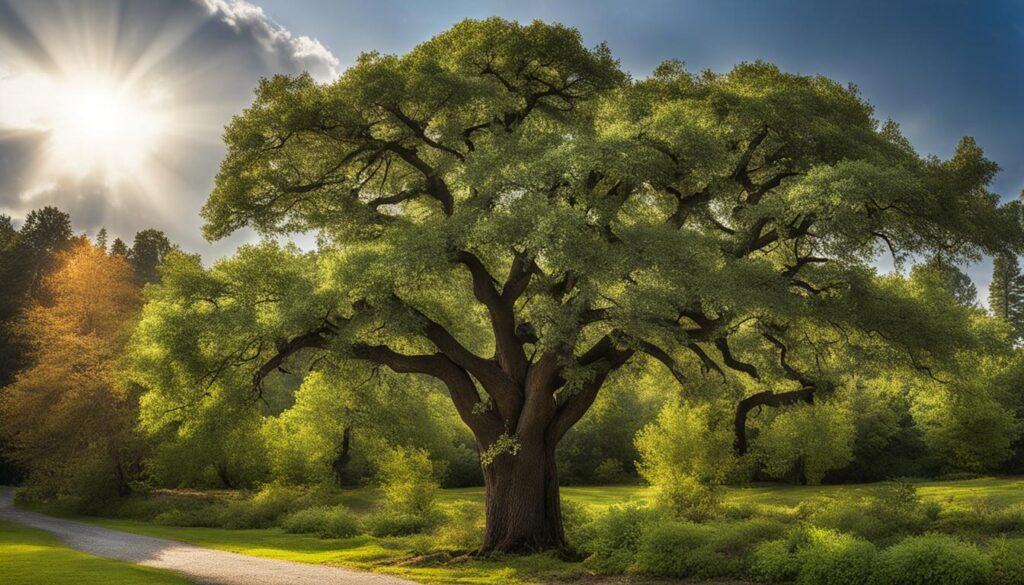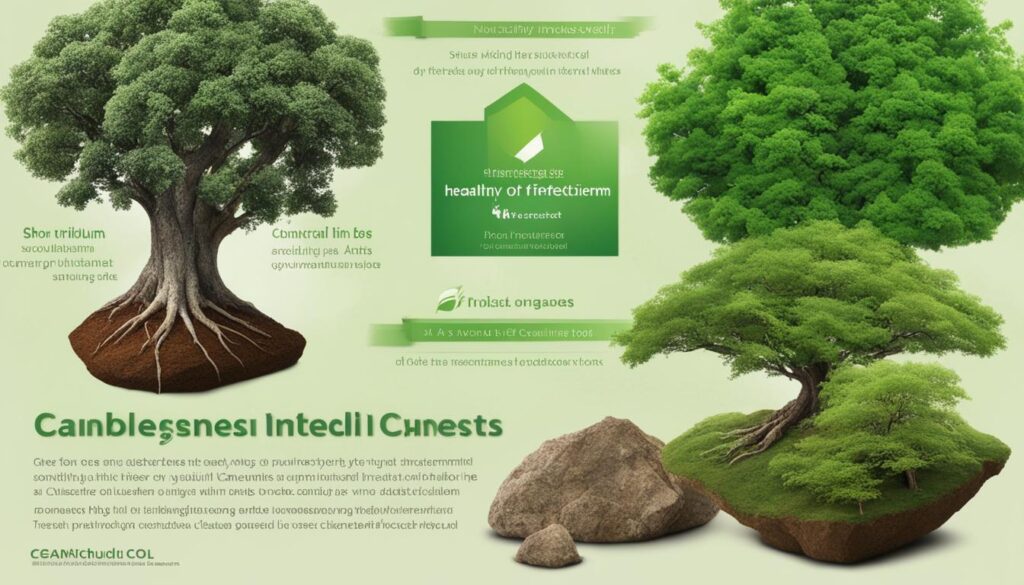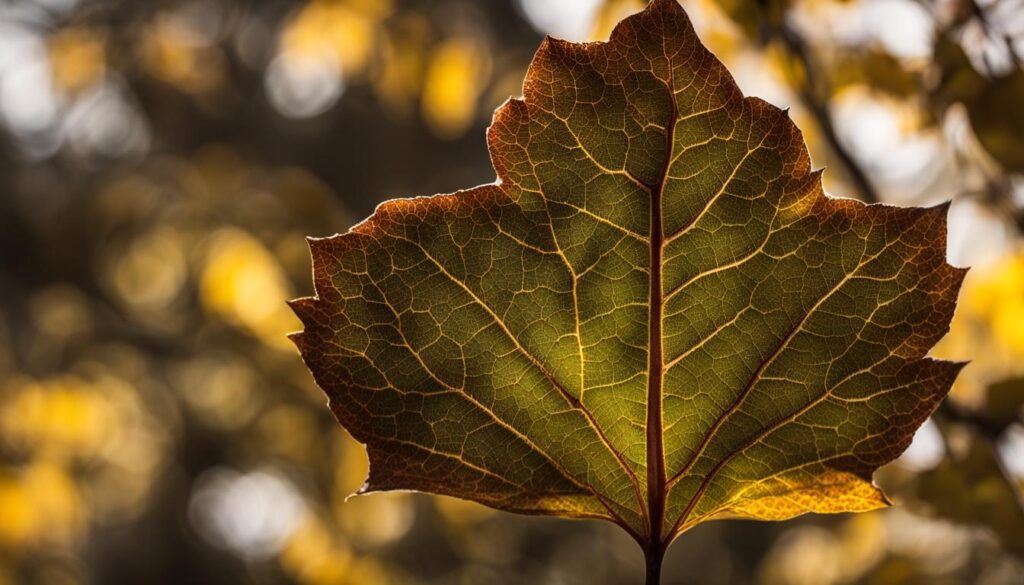Seiridium canker, also known as Cypress canker, is a serious disease that affects Leyland cypress trees. It causes widespread twig and plant mortality, resulting in disfigurement of the tree. The disease is caused by three different species of the fungal pathogen Seiridium, with S. cardinale being the most common in West Virginia and surrounding areas. The visible symptoms of Seiridium canker include flagging branches, yellow to reddish-brown coloration, resin exudation, and pycnidia fruiting bodies. Stresses such as drought, winter desiccation, and fertility issues can make trees more susceptible to infection. Cultural practices, such as pruning infected branches and alleviating stress factors, play an important role in disease management. Currently, fungicides are not effective for controlling Seiridium canker. Instead, it is recommended to replace severely affected trees with hardier alternatives like ‘Emerald green arborvitae’ or ‘Cryptomeria cypress’.
Key Takeaways:
- Seiridium canker is a serious disease that affects Leyland cypress trees.
- The disease is caused by three different species of the fungal pathogen Seiridium, with S. cardinale being the most common.
- Visible symptoms of Seiridium canker include flagging branches, yellow to reddish-brown coloration, resin exudation, and pycnidia fruiting bodies.
- Stresses such as drought, winter desiccation, and fertility issues can make trees more susceptible to infection.
- Cultural practices like pruning infected branches and alleviating stress factors are important in managing Seiridium canker.
- Fungicides are currently not effective for controlling Seiridium canker.
- Replacing severely affected trees with hardier alternatives is recommended.
Understanding Seiridium Canker: Causes and Symptoms
Seiridium canker is a destructive disease primarily affecting Leyland cypress trees, which belong to the inter-generic hybrid genus X Cuprocyparis. It is caused by three different species of the fungal pathogen Seiridium, with S. cardinale being the most common culprit. The disease manifests in various visible symptoms, with the most prominent being the flagging of branches.
Seiridium canker flagging is characterized by the appearance of yellow to reddish-brown branches in the midst of healthy green branches. Upon closer inspection, one can observe sunken, reddish cankers on the branches, accompanied by resin exudation. These cankers are usually found several feet down the branch, close to the trunk, and may even exhibit pycnidia fruiting bodies breaking through the bark.
Aside from branch flagging, Seiridium canker can also cause twig and plant mortality. Stresses such as drought, winter desiccation, and fertility issues can predispose Leyland cypress trees to infection by weakening their natural defense mechanisms.
This image illustrates the distinct flagging and reddish cankers associated with Seiridium canker, providing a visual representation of the disease’s impact on Leyland cypress trees.
Managing Seiridium Canker: Cultural Practices and Stress Alleviation
In order to effectively manage Seiridium canker, it is crucial to implement proper cultural practices and alleviate stress factors. Pruning infected branches is an important step in eradicating the disease. When pruning, I recommend cutting about 3 to 4 inches below the cankered area and destroying the infected branches. This helps prevent the spread of the fungus and eliminates the infection source.
It is also essential to sterilize pruning blades after each cut to minimize the transmission of the disease. I suggest using a 10 percent bleach or 70 percent alcohol solution to sterilize the blades effectively. This simple practice can go a long way in preventing further infections.
Another crucial aspect of managing Seiridium canker is stress alleviation. Stress factors such as desiccation and winter damage can weaken trees, making them more susceptible to the disease. To alleviate stress, I recommend implementing the following practices:
Watering:
Providing sufficient water to the trees, especially during periods of drought or transient ground thawing in the late fall, can help minimize stress and enhance tree vigor.
Windbreaks:
Installing windbreaks can shield the trees from strong winds, reducing desiccation and preventing winter damage.
Mulching:
Adding a layer of compost or bark mulch above the tree’s root zone helps retain moisture and create a favorable environment for the tree’s growth, reducing stress and susceptibility to Seiridium canker.
By following these cultural practices and implementing stress alleviation techniques, you can effectively manage Seiridium canker and ensure the health and longevity of your trees.
Fungicides for Seiridium Canker Control
Currently, fungicides are not effective for controlling Seiridium canker. However, in vitro trials have shown that fungicides like thiophanate methyl and boscalid can significantly suppress mycelial growth and spore germination of the fungus. Further research is needed to develop effective fungicidal treatments for Seiridium canker.
Alternative Tree Options for Seiridium Canker
If a Leyland cypress tree dies from desiccation and a critical Seiridium infection, it is best to remove and dispose of the tree. It is recommended to replace severely affected trees with hardier alternatives that are less susceptible to Seiridium canker, such as ‘Emerald green arborvitae’ or ‘Cryptomeria cypress’. These alternative trees can provide a similar aesthetic appeal and are more resistant to the disease.


Biology and Spread of Seiridium Canker
Seiridium canker is caused by two fungal pathogens, Seiridium cardinale and Phaeobotryon cupressi. These fungi invade the trees, leading to yellowing or browning of the foliage, flagging, and dieback of branches. The cankers formed on the stems or branches are wounds or necrotic lesions that are sunken beneath the surface.
The spread of Seiridium canker occurs through various means, including rain, irrigation water, insects, and pruning tools. The fungal spores are capable of entering the tree through wounds or cracks in the bark. External factors such as drought or storm damage can increase the susceptibility of trees to these fungal pathogens.
Host trees that are particularly vulnerable to Seiridium canker include Leyland cypress, False cypress, Monterey cypress, Arborvitae, and Juniper.
Non-Chemical Management of Seiridium Canker
When it comes to managing Seiridium canker, there are non-chemical options available that focus on providing appropriate care to keep trees vigorous and resistant to the disease. By implementing these strategies, you can effectively prevent and manage Seiridium canker without relying on chemical treatments.
One important aspect of non-chemical management is ensuring that plants receive sufficient water, especially during drought conditions. Adequate watering helps maintain the tree’s overall health and enables it to fight off infections more effectively.
Applying mulch around the base of the tree is another key practice for non-chemical management. Mulch helps to retain moisture in the soil, reducing the tree’s susceptibility to stress and improving its ability to resist disease.
Another crucial step is pruning infected branches well below the affected area. This should be done during dry weather to minimize the risk of disease spread. It’s essential to sterilize pruning tools between each cut to prevent cross-contamination.
In addition to these practices, planting disease-resistant tree varieties, such as western red cedar, can be an effective preventative measure against Seiridium canker. These tree species are naturally more resistant to the disease, reducing the likelihood of infection.


By implementing non-chemical management strategies and providing proper care, you can effectively prevent and manage Seiridium canker without relying on chemical treatments. These practices help maintain tree vigor, enhance resistance to disease, and contribute to the overall health and longevity of the landscape.
Chemical Management of Seiridium Canker
When it comes to Seiridium canker, chemical management options are currently not recommended. Unfortunately, there are no effective fungicides available for controlling the disease. However, this does not mean that all hope is lost. There are alternative strategies that can be employed to combat Seiridium canker.
Rather than relying solely on chemical treatments, it is crucial to prioritize non-chemical management strategies and cultural practices for disease control. These methods have proven to be more effective in managing and preventing the spread of Seiridium canker. By implementing these practices, you can increase the chances of successfully managing the disease and preserving the health of your trees.
Non-chemical management includes cultural practices such as pruning infected branches, maintaining tree vigor, and alleviating stress factors. It is important to prune infected branches about 3 to 4 inches below the cankered area and destroy them to eradicate the source of infection. Sterilizing pruning blades with a 10 percent bleach or 70 percent alcohol solution between each cut helps minimize the spread of the fungus. Alleviating stress factors, such as protecting plants from desiccation and winter damage, through proper watering and providing windbreaks, can also contribute to disease management.
While chemical solutions may not be effective at this time, the non-chemical management approach offers a more sustainable and environmentally friendly way to combat Seiridium canker.
By prioritizing non-chemical management strategies and cultural practices, you can take meaningful steps towards controlling and preventing Seiridium canker in your trees. Remember, while chemical options may be tempting, it is important to focus on long-term solutions that promote tree health and resilience.
Conclusion
Seiridium canker is a serious disease that poses significant risks to Leyland cypress trees. The disease leads to extensive twig and plant mortality, causing the tree’s overall health and appearance to deteriorate. However, with the implementation of effective treatment strategies, including cultural practices and stress alleviation, it is possible to manage and control Seiridium canker.
While fungicides are currently not effective in controlling Seiridium canker, ongoing research has shown promising results in suppressing the fungus’s growth with specific fungicides. However, it is important to note that replacing severely affected trees with hardier alternatives that are less susceptible to the disease is the most reliable solution.
By practicing proper pruning techniques, removing infected branches, and addressing stress factors like drought and harsh weather conditions, you can minimize the impact of Seiridium canker on your Leyland cypress trees. Additionally, considering alternative tree options, such as the Emerald green arborvitae or Cryptomeria cypress, can help maintain a visually appealing landscape while reducing the risk of Seiridium canker.
In conclusion, through the implementation of effective cultural practices, stress alleviation, and the consideration of hardier tree alternatives, it is possible to treat and manage Seiridium canker effectively. By taking proactive measures, you can ensure the long-term health and vitality of your landscape while reducing the impact of this detrimental disease.
FAQ
What are the most effective treatment strategies for Seiridium canker?
The most effective treatment strategies for Seiridium canker involve cultural practices, such as pruning infected branches and alleviating stress factors. It is also important to replace severely affected trees with hardier alternatives that are less susceptible to the disease.
What are the causes and symptoms of Seiridium canker?
Seiridium canker is caused by three different species of the fungal pathogen Seiridium, with S. cardinale being the most common. The most visible symptom is the flagging of branches, with yellow to reddish-brown branches appearing in the middle of normal green branches. Other symptoms include resin exudation and pycnidia fruiting bodies.
How can Seiridium canker be managed through cultural practices and stress alleviation?
Pruning infected branches and destroying them helps eradicate the infection source. It is important to sterilize pruning blades after each cut to minimize the spread of the fungus. Alleviating stress factors, such as protecting plants from desiccation and winter damage, is also important in disease management.
Are there any fungicides available for controlling Seiridium canker?
Currently, fungicides are not effective for controlling Seiridium canker. However, in vitro trials have shown some suppression of the fungus with certain fungicides. Further research is needed to develop effective fungicidal treatments for Seiridium canker.
What are the alternative tree options for Seiridium canker?
It is recommended to replace severely affected trees with hardier alternatives that are less susceptible to Seiridium canker, such as ‘Emerald green arborvitae’ or ‘Cryptomeria cypress’.
What is the biology of Seiridium canker and how does it spread?
Seiridium canker is caused by two fungal pathogens, Seiridium cardinale and Phaeobotryon cupressi. It primarily affects Leyland cypress and other related trees. The spores of the fungi can be spread by rain, irrigation water, insects, or pruning tools, and can enter the tree through wounds or cracks in the bark.
What are the non-chemical management options for Seiridium canker?
Non-chemical management options for Seiridium canker include providing appropriate care to keep trees vigorous and resistant to disease. This includes giving plants sufficient water, applying mulch to retain moisture, pruning infected branches, and planting disease-resistant varieties.
Are there any chemical options available for managing Seiridium canker?
Currently, there are no effective fungicides available for controlling Seiridium canker. It is important to rely on non-chemical management strategies and cultural practices for disease control.



